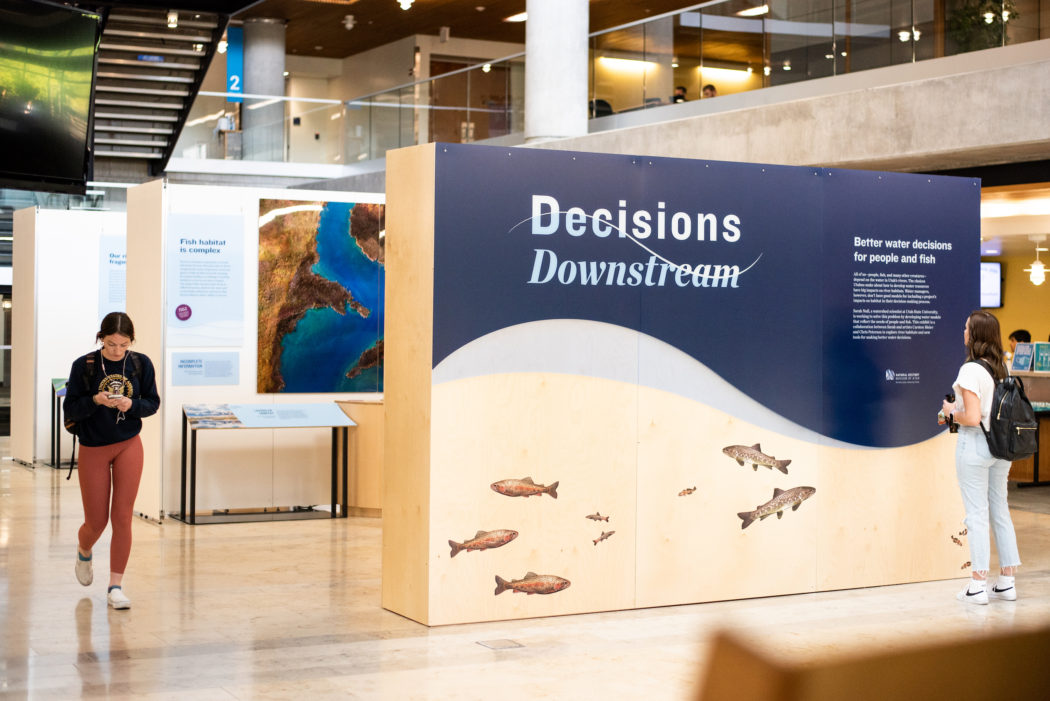Library showcases downstream decisions
Have you ever spent the time to really think about where your water comes from? Or the ecosystems affected by your water use? Do dams affect fish and other aquatic species?
These are some questions Sarah Null, an associate professor with Utah State University’s Watershed Sciences, wants students to consider more as our water resources face an uncertain future.
Null has a hands-on research program here at USU, where she and her watershed students focus on water resource management — especially environmental management. They spend time modeling and measuring habitats in rivers in order to find ways to fit the needs of the ecosystems into water resource management.
Null said they are ultimately trying to protect aquatic ecosystems while maintaining water resource benefits for those who live in water scarce regions throughout the American West. Her team has been exploring different tools used to make better decisions when it comes to water.
“Here in Utah, we have a bunch of different options on the horizon,” Null said, “from buying new dams to water banking, which is now legal following legislation last winter.”
Null wanted these issues to be brought up in a way that might spark some emotion in a person who isn’t a scientist — or studying watershed sciences. She accomplished this by featuringan exhibit that is equal parts art and science titled “Decisions Downstream.” This exhibit was originally placed at the Natural History Museum of Utah but is currently set up on the first floor of USU’s Merrill-Cazier Library.
“We wanted this exhibit to spark interest in people enough that they might go and check out the rivers near them,” Null said. “Or they might, you know, go to a meeting about water management, or even just talk about it with friends and family. We really are trying to bring attention to these issues that affect both the river ecosystems and humans.”
To accomplish this goal, Null teamed up with artists Chris Peterson and Carsten Meier. With the help of Null and her students research, these artists created huge panels, a large and vibrant painting of a freshwater fish, and set up educational projections. According to Null, the art visualized her work amazingly.
“My favorite part was working with artists,” Null said. “This was really new to me because as a scientist I often only work with other scientists. They were able to make my work into huge artwork. When you walk in the library they’re right there. You just can’t miss them. That part was so exciting for me.”
The exhibit offers educational panels about the trade-offs associated with human interference, as well as the ways these trade-offs affect different species of fish and humans. There was also a panel that explained how our rivers are fragmented, which proves to be a big threat to many aquatic species.
Possible examples of improving our water systems in order to reconnect our fragmented rivers were also on display.
One of the panels states: “While removing large barriers like dams is daunting, rethinking smaller barriers that block fish movement is quite feasible and can have big impacts.”
This is exactly the type of thinking that Null wants to instill in her students, as well as those who see her exhibit. Building dams and providing water to people in agriculture is obviously important and needed, but Null wants to probe the question of, “How much is enough?”
“I want students to consider what other species and ecosystems also share our same water resources,” Null said, “and how can we make sure to provide water for these habitats, so we can continue fishing and rafting and all those fun things we enjoy — while also providing water supply.”
Null encouraged students who are interested in these topics to get involved. She mentioned there are many meetings going on open to the public in terms of rationing and thinking about the best ways to preserve Utah’s rivers, lakes and streams.
Students can also go to public hearings or go online and submit comments for different water resource issues.
“There are many ways to get involved,” Null said. “Me and a number of other faculty in my department are always looking for undergraduate students to get educated about these water issues, and to help with research.”
You don’t have to be a watershed or natural resources student to contribute to the cause. Null said communicators of all kind are needed to broaden the audience for these pressing topics, especially since science can often times be dry. This is exactly why she teamed up with artists for this project.
“Pairing with artists is a really great way to bring some meaning, feeling, emotion and new ideas to science,” Null said.
One of the artists Null had on her team, Chris Peterson, uses his art to communicate science. Outside of this exhibit, Peterson creates wildlife and landscape paintings.
“My work is about the collective loss of wildness, nostalgia and the residue left on the psyche by wild animal encounters,” Peterson said. “It is meant as both an elegy for — and celebration of — charismatic megafauna on the brink.”
Null’s and Peterson’s goals are quite similar in how they want to show the public these difficult, and often times sad, realities in a way to inspire others to take action. Scientists’ extensive research paired with artists’ creativity can create education that is accessible and admirable by others.

